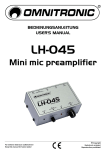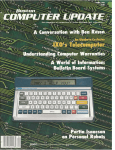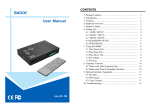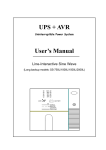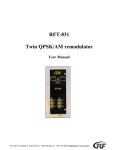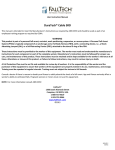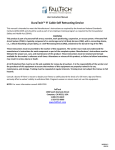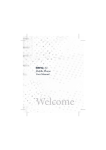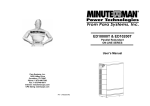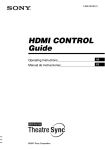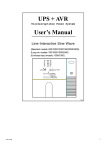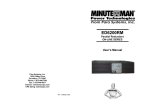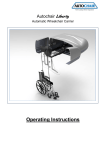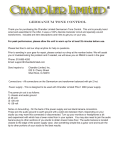Download User`s manual in acrobat pdf-format 170k
Transcript
MEGAVOICE 2000 MULTIPURPOSE TELECOMPUTER USER´S MANUAL Model code 6000 2003 Version 000 31 00 01 Duratech Oy www.duratech.net MEGAVOICE 2000 V.3.1 MANUAL V.2000-09-20 1.2 THE STRUCTURE OF MEGAVOICE The name and model Expansion place for display Cable connector Cn1 -Power -grounding if needed -Line 1 and 2 Connector for display and V.24 port Indicators -Green / Yellow/red -functions OK, wait, error -Recording level meter low, satisfactory, too high Expansion slot Interface for line recording Connector for hand set, for recording and monitoring Input level adjustement Front panel switched Sw1 ...Sw8 -Control special functions -normally not used DAY MODE NIGHT MODE VACATION PROGRAMMING Mode switch Under the unit there may be a hidden installation bar. All right are reserved. Specifications may change during the product development. MEGAVOICE 2000 V.3.1 MANUAL V.2000-09-20 1 2. RECORDING The messages of the announcer must be recorded and stored before use. Usually the spoked masseges are stored using normal telephone. The unit is controlled with DTMF-code commands. Also it is possible to enter recording using line interface in the front panel from CD or tape recorder. In order to program the user must enter programming state. 1-way : It can be reached by using the front panel Program-switch, and calling the 1st line if the mode switch is active. The unit gives spoken voice guide. The programming mode is ended when the switch is placed into another position. This requires that the unit is programmed to operate this way. 2way is that the unit called using L1-line. When the unit answers the user gives * 0 <password> # command and enters the programming state. The programming state is ended with * 0 # command then. Megavoice can have up to 9 messages 1...9. Here a message number is indicated using m. Message 9 is voice guide. Installer sets up or uses the default values to control the unit give certain message on certain line or certain mode (day/night/vacation/program). The old messages is played back with * 3 m #, like * 31# for message 1. Message is removed with * 1 m # and new message is recorded with * 2 m #. Recording and playback stops with #. The recording level is suitable when the red led flashes now and then. The programming messages are decribed in the Programming section of this manual. RECORDING TECHNIQUES The recordings can be entered with telephone call, head set mic-connected directly to Megavoice, with line level ( 0.8 V) interface from CD or recorded or PC. The operations are controlled in all cases using line 1 with a DTMF telephone. The levels or the mic and Line interface can be adjusted with a level setting in the front panel. The best result can be reached using front panel line interface but telephone is usually adequide. The recordings can be edited using PC or recorders. With suitable sofware the voice can be compressed and mixed for the telephone lines but this needs some knowledge. Many times the recordings can be mixed acustically ; the back ground music can be recorded using CD-player playing on the back ground on the desk. This takes some test runs but it works well. If PC software compression is used, cut the low (<200Hz) and high frequncies (>4kHz) before compression . Good results are obtained using 1:4 compression for telecom network. Red led is -9dBm, yellow is -17dBm, green is -23dBm. -9Bd is apx. the level of the dial tone in the telephone network which is usually the target level of the messages. It is good idea to compare own recordings with dial tone. Usually the recording level is ok if the red led flashes occasionally. Automatic level adjustement is not used because it can not be controlled well. 2 MEGAVOICE 2000 V.3.1 MANUAL V.2000-09-20 2 3. INSTALLATION 3.1 MECHANICAL INSTALLATION Megavoice is placed into a suitable place and line cable kit is connected to the D25 connecter in the front panel. The power supply is connected. The extention line are connected to the line cable. See schematics for details. One line can be connected to tele line or 600 ohm line. Also E&M signaling can be used. A additonal 2x16 character display can be connected to Display-connector. 3.2 QUICK START GENERAL - OK is 2 beeps, - Wait/infomation tone is one beep, - Error tone is 9 beeps. - All commands start with * and end with #. Detailled commands are in installation manual. 1. Install Megavoice cables. 1A. If front panel mode switch is used place it into Program state. 2. Ring line 1. Its extention number is _____________. ( Installer fills in) If necessary dial DTMF sending start prefix _________ ( == ) 3 A. If front panel mode switch is used wait for 2 beeps, OK. 3.B. if switch is not used : Dial * 0 password #, (login) immediately the device answers. Password here is nnnnnn. Programming state is reached this way. If password is not used * 0 #, can be used . megavoice answers with OK beeps. If not try to call again. 4. Play an old message 1. Dial command * 3 1#. Device plays back message 1. This way m -message is played back with * 3 m # command. # stops playing 5. Erase old message 1. Dial * 1 1 #. This way m-message is erased with * 1 m #. Device beeps till it gives OK beep. Message 9= guiding tone and it can only be erased with switch 8 =1. 6. Record message 1. Dial command * 2 1 #. Wait 2 s for a start beep and record new message with a hand set or CD with line connector. Stop with #. Device gives then OK beep. If error or out-ofmemory-error it gives error-tone. 7. Repeat steps 4...6 for necessary messages. The meaning of different messages are hopefully written by installator to chapter 3.4 8. Now the installator can enter other set ups. The line answer/delays, transfer target numbers etc. must be entered. 9. Finally exit the programming state. 9.A If Mode Swich is used , switch it off the Programming state and it cuts the line. 9B. if mode switch is not used : Logout with * 0 # command or the device logs out after 222s of no-commands-state. 10. Test everything. MEGAVOICE 2000 V.3.1 MANUAL V.2000-09-20 3 3.4 MEGAVOICE 2000 - INSTALLATION DATA PLACE : ________________________________________________ PABX TYPE : ________________________________________________ LINE 1 EXTENTION :_________________ LINE 2 EXTENTION :_________________ PABX DTMF START CODE : ___________________ MESSAGE : MEANING MESSAGE 1 : _______________________________________________________________________ _______________________________________________________________________ MESSAGE 2 : _______________________________________________________________________ _______________________________________________________________________ MESSAGE 3 : _______________________________________________________________________ _______________________________________________________________________ MESSASE 4 : _______________________________________________________________________ _______________________________________________________________________ MESSAGE 5 : _______________________________________________________________________ _______________________________________________________________________ MESSAGE 6 : _______________________________________________________________________ _______________________________________________________________________ MESSAGE 7 : _______________________________________________________________________ _______________________________________________________________________ MESSAGE 8 : _______________________________________________________________________ _______________________________________________________________________ MESSAGE 9 : _______________________________________________________________________ VOICE GUIDE * 1 message number # is erasing, * 2 msg * 3 message number # is play back … number # is recording, Message 9 can only be erased with sw8 down. 4 MEGAVOICE 2000 V.3.1 MANUAL V.2000-09-20 4 3.5 FRONT PANEL MODE SWITCH Megavoice can be equipped with a front panel mode switch. Is sets MV into day/night/vacation/program mode. There are 4 modes and a mode controls freely which message is used and how does a line operate. Many times the unit is progammed so that when the mode is Program, a call to the 1st line enters the programming state directly and the unit gives voice guide explaining different commands. Voice guide repeats every 45s is nothing is done. The programming mode can be existed turning the switch off the Program state then. EXAMPLE : -In day mode he unit answers calls directly, announces a service number message and . transfers the call into extention group. -In day mode the unit answers and gives night message and hungs up. -In vacation mode the unit gives adjustable vacation message and hungs up. -In program mode the unit answers and enters programmin state and exits it when swithed off it. DAY MODE NIGHT MODE VACATION PROGRAMMING 3.6 DAY/NIGHT CONTROL A picture of the mode switch Megavoice 2000 can be also set into day/night/vacation mode by remote control if the mode switch is not used. First line is called and a right command is entered immediately when megavoice answers. The Programming mode is not needed in this case. The right command can be programmed into speed dialing or programmable key of the telephone set. The state can be tested by callin megavoice again. If state is not correct, the programming of mode can be redone. See commands starting with *4 if necessary EXAMPLE 1 : Call Megavoice 1st line using __________________ and after 2 s -For day mode : press key marked “Day mode “. -For night mode : press key marked “Night mode”. -For vacation mode: press key marked “Vacation mode”. EXAMPLE 2 : Call Megavoice 1st line using ___________________________. and wait for 2 s and press then : -For day mode * 41 * * 111# -For Night mode * 42 * * 111# -For Vacation mode * 43 * * 111#. Note: Here the password starts with 111... . MEGAVOICE 2000 V.3.1 MANUAL V.2000-09-20 5 4. PROGRAMMING 4.1 GENERAL Megavoice is controlled with DTMF codes by calling to the Line L1 with a DTMF telephone. One command starts with * and ends with #. Eg. Play back message 1 is * 3 1 # Megavoice replays with 2beeps=OK-tone, or with 9-beeps=Error-tone, or 1beep= wait/ information tone. If remote programming is used, the first command is login and the last is logout. Megavoice logouts if no command are used for 3 minutes. If front panel mode switch is used Megavoice logs in by a call to L1 when mode switch is in the Programming state. Megavoice logs out then when the switch is removed from Programming state and there is no need for separate logout /login commands (* 0 # ). LCD display indicates OK and ERROR messages and many useful information, like free memory, or how many calls per line. The programming is easier with a LCD. Megavoice has 2 (or 6) lines. They each have 4 modes : Day/night/vacation/ programming. There are 9 possible messages. During installation the functioning of the line must be programmed; direct/delayed answer AND information or message+transfer+number. Also the message given in different line/mode states must be entered. Default values can be used, which saves some work. 4.2 FRONT PANEL SWITCHES 1 The front panel switches are not usually used, but can be used in special cases during installation. Normally they are all up (0 position ). 0 8 OFF ON 1 SW 12 3 4 5 6 7 8 Switch 8 : If down (1), All passwords are accepted as * 0 # command. Also must be down if message 9 or all messages are erased. 6 MEGAVOICE 2000 V.3.1 MANUAL V.2000-09-20 6 5. MEGAVOICE COMMANDS V.3.1 This expains the different commands. 5.1 LOGIN INTO PROGRAMMING STATE (0) * 0 n n n n n n # OR * 0 # if password is not used. Read the note. ,nnnnnn=password with 6 numbers. Default nnnnnn = is not written here. Display : Before command "Login". Device : Line 1 is called. Some PABX require that a function code is now entered to start DTMF-sending. It is stated is the PABX manuals. Wait for megavoice answer. Dial * 0 nnnnnn #. Megavoice sends OK-beeps, green led is lid and the display indicated "Enter command". The message of the line is halted. When megavoice answers the line, it waits for 2 second before it starts its message. Dial this comand immediately the Megavoice answers. The Spoken message may interface with the Dual-Tone-codes.Eg. * 0 123456 #. Note : If mode switch is activated and the device is in PROGRAM-state, * 0 # is not used for login. Megavoice answers calls on L1 and goes directly into programming state and gives 2 beeps= OK. 5.2 LOGOUT OF THE PROGRAMMING STATE (0) * 0 # Read the note. When used during programming, program exits the programming state and hangs up. Display indicates "logout " followed by "login". Eg. * 0 #. Note : If Mode Switch is activated AND the Mode Switch is in Program-state, THEN the line is hung up if the switch is changed into other state. Useful to exit the programming state. 5.3 ERASE MESSAGE (1) * 1 m# m= message number 1... muodossa. If m=* * clear all messages (= command *1* * # ). Default is all messages empty. Guiding message 9( and all) can be erased only if sw8 is 1=down.Megavoice : Beeps once for every 8 s erased. When ready beeps twice as OK-tone. Error tone (9-beeps) is given when there is an error. Eg. Erase message 1 is * 1 1 #. Erase message 2 is * 1 2 #. 5.4 RECORDING MESSAGE (2) * 2 m# m= message number 1...9 Megavoice : Gives one beep 2 s after this comend to indicate start of recording. Recoring is stopped with # command or with 9-beeps error tone is memory is full or message is not empty. # beep is not recorded. The front panel leds acts as UV level meter. The red led may occasionally flash during recording. Recordings are stored into chip memory for 20 years. See also chapter Recoring. Message must be erased before recording a new one. Eg. Record msg 1 is * 2 1 #. Eg Dial * 2 1 #, wait for a beep, record and stop with #. Play back it with * 3 1#. (See 5.5) 5.5 PLAY MESSAGE (3) * 3 m # m= Message number 1...9 . Command plays back a recorded message. megavoice : Gives on wait-beep and play message mm , ends with wait -beep, and gives OK-beeps.Display indicates the number of the message. Play back can be stopped with #. Eg Play the message 1 is * 3 1 #. Play back msg 2 is * 3 2 #. AS EASY AS 1-2-3 : ERASE- RECORD-PLAY BACK MEGAVOICE 2000 V.3.1 MANUAL V.2000-09-20 7










